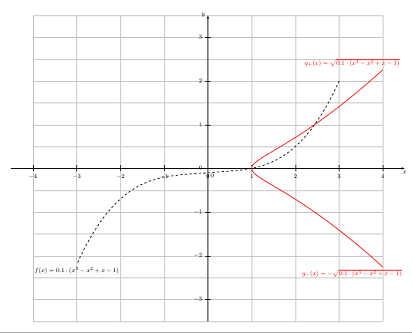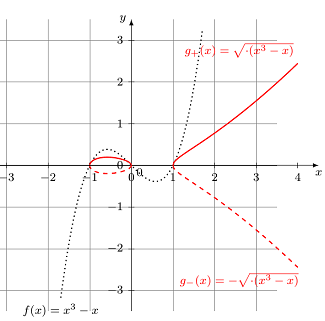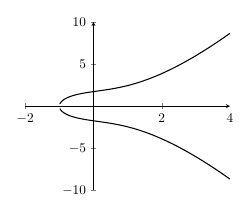|
Ich würde gerne in LaTeX Kurven der Form y^2=x^3+ax+b zeichnen. Ich habe mir einiges zu TikZ durchgelesen und kann auch Funktionen wie sin(x) usw zeichnen. Aber die Kurven mit obiger Form bekomme ich nicht hin. Kann man das überhaupt mit TikZ machen? Ansonsten habe ich noch keine Erfahrung wie man Kurven in Latex zeichnen kann. Gibt es etwas einfaches für Anfänger? |
|
So, ich hab ja für sowas meine guten Vorlagen... ;) Auf Deine Frage, wie man sowas (nur) mit TikZ macht:
\documentclass[margin=5mm, tikz]{standalone} \usepackage[ngerman]{babel} \usepackage{tikz} \usepackage{amsmath, amssymb} %=========== \begin{document} %=========== \begin{tikzpicture}[ x=1cm, y=1cm, scale=1.0, font=\footnotesize, >=latex %Voreinstellung für Pfeilspitzen ] % Gitternetzlinien \draw[xstep=1cm, ystep=0.5cm, very thin, color=lightgray] (-4,-3.5) grid (4,3.5); % x-Achse \draw[->] (-4.5,0) -- (4.5,0) node[below] {$x$}; %Zahlen auf x-Achse \foreach \x in {-4,...,4} \draw[shift={(\x,0)},color=black] (0pt,2pt) -- (0pt,-2pt) node[below] {\footnotesize $\x$}; % y-Achse \draw[->] (0,-3.5) -- (0,3.5) node[left] {$y$};%node[above left] %Zahlen auf y-Achse \foreach \y in {-3,...,3} \draw[shift={(0,\y)},color=black] (2pt,0pt) -- (-2pt,0pt) node[left] {\footnotesize $\y$}; %Ursprung \draw[color=black] (0pt,-5pt) node[right] {\footnotesize $0$}; %%%%%%%%%%%%%%%% %% FUNKTIONEN %% %%%%%%%%%%%%%%%% % Kubisches Polynom \draw[thick,color=black, dashed] plot[samples=200, domain=3:-3] (\x,{0.1*(\x^3-\x^2+\x-1)}) node[below] {$f(x)=0.1\cdot(x^3-x^2+x-1)$}; % Wurzel aus Kubischem Polynom - positiver Ast \draw[thick,color=red] plot[samples=200, domain=1:4] (\x,{sqrt(0.1*(\x^3-\x^2+\x-1))}) node[above, xshift=-4em] {$g_+(x)=\sqrt{0.1\cdot(x^3-x^2+x-1)}$}; % Wurzel aus Kubischem Polynom - negativer Ast \draw[thick,color=red] plot[samples=200, domain=1:4] (\x,{-sqrt(0.1*(\x^3-\x^2+\x-1))}) node[below, xshift=-4em] {$g_-(x)=-\sqrt{0.1\cdot(x^3-x^2+x-1)}$}; \end{tikzpicture} %=========== \end{document} %=========== ============================================== Zu Karras AW: Also Dein erstes Bild verstehe ich nicht, wenn ich einfach Deinen Funktionsterm eingebe, erhalte ich den 'Rechten Teil' richtig. Zu dem 2. Bild, wie gesagt: Du mußt streng darauf achten, daß Du Deine Wurzelfunktion nur für positive Argumente zeichnest - TikZ ist kein Zeichenprogramm, anders als Mathematica oder sowas, kommt es sonst nicht klar.
\documentclass[margin=5mm, tikz]{standalone} \usepackage[ngerman]{babel} \usepackage{tikz} \usepackage{amsmath, amssymb} %=========== \begin{document} %=========== \begin{tikzpicture}[ x=1cm, y=1cm, scale=1.0, font=\footnotesize, >=latex %Voreinstellung für Pfeilspitzen ] % Gitternetzlinien \draw[ help lines] (-3.5,-3.5) grid (3.5,3.5); % x-Achse \draw[->] (-4.5,0) -- (4.5,0) node[below] {$x$}; %Zahlen auf x-Achse \foreach \x in {-4,...,4} \draw[shift={(\x,0)},color=black] (0pt,2pt) -- (0pt,-2pt) node[below] {\footnotesize $\x$}; % y-Achse \draw[->] (0,-3.5) -- (0,3.5) node[left] {$y$};%node[above left] %Zahlen auf y-Achse \foreach \y in {-3,...,3} \draw[shift={(0,\y)},color=black] (2pt,0pt) -- (-2pt,0pt) node[left] {\footnotesize $\y$}; %Ursprung \draw[color=black] (0pt,-5pt) node[right] {\footnotesize $0$}; %%%%%%%%%%%%%%%% %% FUNKTIONEN %% %%%%%%%%%%%%%%%% % Kubisches Polynom \draw[thick,color=black, dotted] plot[samples=200, domain=1.7:-1.7] (\x,{(\x^3-\x)}) node[below] {$f(x)=x^3-x$}; %Rechter Teil % Wurzel aus Kubischem Polynom - positiver Ast \draw[thick,color=red] plot[samples=200, domain=1:4] (\x,{sqrt(0.1*(\x^3-\x))}) node[above, xshift=-4em] {$g_+(x)=\sqrt{\cdot(x^3-x)}$}; % Wurzel aus Kubischem Polynom - negativer Ast \draw[thick,color=red, dashed] plot[samples=200, domain=1:4] (\x,{-sqrt(0.1*(\x^3-\x))}) node[below, xshift=-4em] {$g_-(x)=-\sqrt{\cdot(x^3-x)}$}; %Linker Teil % Wurzel aus Kubischem Polynom - positiver Ast \draw[thick,color=red] plot[samples=200, domain=0:-1] (\x,{sqrt(0.1*(\x^3-\x))}) node[] {}; % Wurzel aus Kubischem Polynom - negativer Ast \draw[thick,color=red, dashed] plot[samples=200, domain=0:-1] (\x,{-sqrt(0.1*(\x^3-\x))}) node[] {}; \end{tikzpicture} %=========== \end{document} %=========== |
|
Ein Beispiel mit Das Beispiel ist sehr einfach, das meiste ist nur Setzen der Achsenparameter: \documentclass[border=10pt]{standalone} \usepackage{pgfplots} \pgfplotsset{width=7cm, compat=1.5.1} \pgfmathdeclarefunction{funktion1}{0}{\pgfmathparse{sqrt(x^3 + 2*x + 3)}} \begin{document} \begin{tikzpicture} \begin{axis}[ axis y line = middle, axis x line = middle, samples = 190, domain = -2:4, xmin = -2, xmax = 4, ymin = -10, ymax = 10, ] \addplot[black, thick, mark=none, ] {funktion1}; \addplot[black, thick, mark=none, ] {-funktion1}; \end{axis} \end{tikzpicture} \end{document}
|


 (Bild stimmt übr. nicht genau, ich hatte noch einen Vorfaktor vom 1. Plot drin)
(Bild stimmt übr. nicht genau, ich hatte noch einen Vorfaktor vom 1. Plot drin)
Da ich gerade nicht viel Zeit habe, das komplett zu erstellen: Kannst Du denn Funktionen y = f(x) mit TikZ zeichnen?
Falls ja, ist die Vorgehensweise, daß Du diese implizite Funktion astweise zeichnest, also zwei Wurzelfunktionen. Paß dabei auf, daß die domain so eingestellt ist, das alle Zahlen unter den Wurzeln schön positiv sind.
Wenn Du zu einem Ergebnis kommst, kannst Du es posten, dann kann ich gerne einmal ein Blick drüber werfen.
@karra Ich habe die Folgefrage (die als Antwort gepostet war) in eine echte Frage umgewandelt und eine Antwort dort geschrieben: Wie kann ich die stückweise definierte implizite Funktion y^2=x^3-x zeichnen?